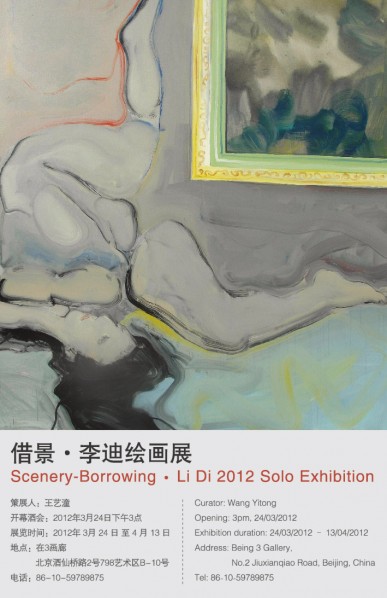
“Scenery-Borrowing: Li Di Solo Exhibition” will be presented by Being 3 Gallery from March 24th through to April 13th. Featuring new works Li Di has created over the past year, the exhibition unfolds from the hind running leg of the diptych Fleet (Kuang Biao), as the front leg, on a grant stride, marks Li Di’s entrance into a pure state of being as an artist. The step that he takes creates an intellectual and cultural space from his travels through time and various locations.
In the 1980s, Li was deeply attracted to pioneer Expressionist art. Driven by enthusiasm for a unique artistic career, this became his goal so he pursued further education in Germany. In his two decades in Europe, a distinct style of calligraphic writing emerged from Li’s painting experience. This calligraphic writing originates from the artist’s emotional and ethnic bond with his Chinese roots, and reflects his search for and confirmation of a certain self-identity. For Li, perhaps, to “write” is to find a ground on which to settle. Li’s brushstrokes in Fleet, free of any restraint, depict a vigorous leg running through a vast field. Like the artist’s life experience, the foot lifts up to cross continents and oceans.
Li's sensible and humble personality as an artist makes his borrowing of scenes during his twenty years in Germany a series of pictorial narrations pertaining to sincere thoughts and feelings. Meanwhile, Li composes his sense of self-identity as a Chinese artist through appreciative portrayals of subjects familiar and intimate to everyday life.
[gallery link="file" orderby="title"]
The exhibition unfolds from the hind running leg in the diptych Fleet, because the front leg, to a grant stride which is already hidden in the thunders of Jingzhe (the Waking of Insects solar term) and the mists of spring rain.
Every element that we see on Li’s canvas is fascinating: luminous rivers and trees in the summer, the taste and smell of hot air; fall matures from passion to confusion; in an instant winter hay burns on bare branches. The front leg on a grand stride extends into the travel of time within seasonal circles. Two legs fleeting, eyes are affected by seasonal colors, ears retain residue with nature’s voice, and fingers dance around the canvas - Impressionist painters loved to capture fleeting moments in life, while Expressionists attempted to embody happenings in one’s inner world - Li borrows from mother nature, combining with energetic colors and brushstrokes, to compose sensual rhythms of time and space as experienced on a daily basis.
New Fauvism paintings’ with non-rhetorical expressions are the context in which Li, as a constant learner of artistic creativity, grows and develops. This context is a stage on which the artist performs, but certainly does not define the artist’s dance. The details in Li's work, like Williem de Kooning’s graffiti-style masterpieces, seem to develop a calligraphic language of its own. The skill and grace of this language, as the basis of Li’s work, makes it possible for Li’s to borrow scenery. Such a means recalls, in many ways, Pollock’s calligraphic language in paintings such as Autumn Colors.
Rain is vague. Thoughts Flame generates forward momentum. The Last Green Apple contains meditation, perhaps accompanied by a slight sigh. Li’s series of scenery generates a whirling motion, sparing no time for stagnation. These scenes also echo particular feelings. Li does not use any individual scene to convey the entity of time, space and emotion. On the contrary, every scene is filled with subtle yet simple detail. We are attracted to and touched by these familiar details. With this intimacy between the viewer and the works, the viewer completes a cycle of running through the four seasons like a free - spirited child. This freedom is the essence behind Li’s brushstrokes. The accumulation of each trace of color engenders warm encounters. Li’s clever decision - making, as well as his calmness and confidence, also come from this freedom. This freedom is both Li’s creation of scenes and emotion, presenting a carefree and simple attitude that accompanies his travels.
The so-called calligraphic writing finds roots only in Li’s creative process. Every stroke is connected with one specific emotion, as well as one particular point in time and space that existed in Li’s personal history, either during his two decades in Germany or in his present life here in China, the span between time and space underlies Li’s paintings. In turn, this exhibition is also the borrowing the scenery of the audience. The artist’s adventures and self - identity, full of power and change, invites constant thinking, unveiling moments captured by his works.
Curator: Wang Yitong
(BA Art History, Franklin & Marshall College, USA)
Scenery-Borrowing: Li Di 2012 Solo Exhibition
Curator: Wang Yitong (BA Art History, Franklin & Marshall College, USA)
Opening: 3pm, March 24th, 2012
Duration: March 24th—April 13th, 2012
Address: Being 3 Gallery, No.2 Jiuxianqiao Road, Beijing, China
Blog: http://blog.sina.com.cn/being3art
Tel: 86-10-59789875




























